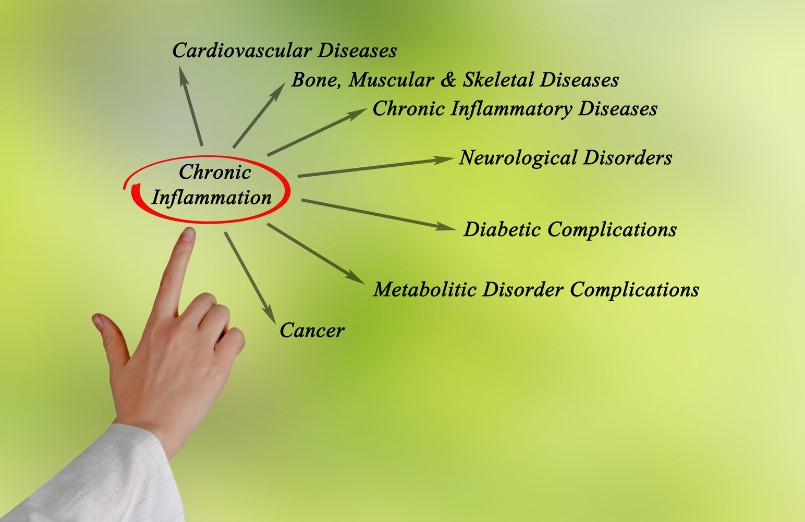Inflammation is a term that has gained considerable attention in the realm of health and wellness, especially among seniors. While it is a natural defense mechanism against infection and injury, chronic inflammation can harm one’s well-being.
This article aims to elucidate the intricacies of inflammation, its adverse effects, and the role of food in modulating inflammatory responses. We will also explore ten anti-inflammatory foods that are particularly beneficial for seniors, followed by a list of foods to avoid.
AND AS A BONUS, I’ve tapped into my culinary toolbox to provide you with five delectable recipes that incorporate anti-inflammatory ingredients.
What is Inflammation?
Inflammation is the body’s innate response to harmful stimuli such as pathogens, damaged cells, or irritants. It is a complex biological process involving various cells and mediators that work in concert to remove the offending agent and initiate tissue repair.
In acute cases, inflammation is a short-term response that subsides once the underlying issue is resolved. However, chronic inflammation is a prolonged, dysregulated, and often detrimental condition that can lead to various health problems.
The Adverse Effects of Elevated Inflammation Levels
Chronic inflammation is implicated in a myriad of health conditions, including but not limited to:
Cardiovascular Diseases: Inflammation contributes to atherosclerosis, leading to heart attacks and strokes.
Arthritis: Inflammatory responses exacerbate joint pain and stiffness.
Cognitive Decline: Elevated inflammation levels are associated with neurodegenerative diseases like Alzheimer’s.
Diabetes: Inflammation affects insulin sensitivity, contributing to Type 2 diabetes.
Cancer: Chronic inflammation can lead to DNA damage, promoting tumorigenesis.
The Role of Food in Inflammation
Diet plays a pivotal role in modulating inflammation. Certain foods can exacerbate inflammatory responses, while others have the potential to mitigate them. Nutrients like antioxidants, polyphenols, and omega-3 fatty acids are known for their anti-inflammatory properties.
The Top Ten List Of Anti-inflammatory Foods:
- Berries: Rich in antioxidants and polyphenols, berries combat oxidative stress.
- Salmon: A great source of omega-3 fatty acids, which reduce inflammation.
- Turmeric: It contains curcumin, a potent anti-inflammatory compound.
- Green Tea: Loaded with catechins, which have anti-inflammatory effects.
- Olive Oil: High in oleic acid and antioxidants.
- Nuts: Almonds and walnuts contain healthy fats and antioxidants.
- Leafy Greens: Spinach and kale are rich in vitamins and minerals.
- Avocado: Packed with monounsaturated fats and fiber.
- Garlic: Contains allicin, which has anti-inflammatory properties.
- Ginger: Known for its anti-inflammatory and anti-oxidative effects.
While we’ve discussed foods that can help mitigate inflammation, it’s equally crucial to understand how certain foods exacerbate this biological response and why their consumption can harm our health.
Here’s a closer look at the mechanisms behind the inflammation-inducing foods listed earlier:
Ten Foods That Cause or Increase Inflammation:
1. Sugar
Mechanism: Sugar triggers the release of pro-inflammatory cytokines, such as tumor necrosis factor-alpha (TNF-α) and interleukins.
Detriment: Elevated cytokine levels can lead to systemic inflammation, contributing to insulin resistance and obesity.
2. Processed Meats
Mechanism: These meats often contain preservatives like nitrates and sulfites, which promote inflammation.
Detriment: Increased inflammation can exacerbate conditions like cardiovascular disease and cancer.
3. Trans Fats
Mechanism: Trans fats can increase levels of low-density lipoprotein (LDL) cholesterol, which is pro-inflammatory.
Detriment: Elevated LDL cholesterol is a risk factor for atherosclerosis and cardiovascular diseases.
4. White Bread
Mechanism: High glycemic index foods like white bread cause rapid spikes in blood sugar, triggering an inflammatory response.
Detriment: Frequent blood sugar spikes can lead to insulin resistance and Type 2 diabetes.
5. Fried Foods
Mechanism: The high heat used in frying produces advanced glycation end products (AGEs), which are pro-inflammatory.
Detriment: AGEs can accelerate aging and worsen chronic diseases like diabetes and cardiovascular disease.
6. Soda
Mechanism: The high sugar content in soda can lead to insulin resistance, promoting inflammation.
Detriment: Chronic inflammation can contribute to obesity and metabolic syndrome.
7. Artificial Sweeteners
Mechanism: Some artificial sweeteners can disrupt gut microbiota, leading to an imbalance that promotes inflammation.
Detriment: Gut dysbiosis can lead to gastrointestinal issues and increased gut lining permeability.
8. Vegetable Oils
Mechanism: High in omega-6 fatty acids, these oils can tip the balance of omega-3 to omega-6, promoting inflammation.
Detriment: An imbalanced ratio can exacerbate inflammatory conditions like arthritis and cardiovascular disease.
9. Alcohol
Mechanism: Excessive alcohol consumption can lead to liver inflammation and disrupt gut microbiota.
Detriment: Liver inflammation can progress to liver disease, while gut dysbiosis can lead to gastrointestinal issues.
10. Processed Snacks
Mechanism: Often high in sugar, salt, and unhealthy fats, these snacks can trigger inflammation.
Detriment: Regular consumption can lead to weight gain, elevated cholesterol, and high blood pressure, all associated with chronic inflammation.
If any or all of these inflammatory staples are a part of your regular diet, you will be righteously rewarded to limit or omit their consumption. For every harmful food component you change or eliminate, there is a whole host of healthy alternatives readily available to take its place.
You won’t miss a thing!
As promised, some delicious and healthy recipe options for including anti-inflammatory foods in your daily diet are below. Bon Appetite!
BONUS:
Five Healthy Recipes Utilizing Anti-inflammatory Foods
Berry Smoothie
Ingredients: 1 cup mixed berries, 1 cup almond milk, 1 tbsp chia seeds
Instructions: Blend all ingredients until smooth. Serve immediately.
Grilled Salmon Salad
Ingredients: 6 oz salmon fillet, 2 cups mixed greens, 2 tbsp olive oil, 1 tbsp lemon juice
Instructions: Grill the salmon until cooked. Toss with mixed greens. Drizzle with olive oil and lemon juice.
Turmeric Latte
Ingredients: 1 tsp turmeric powder, 1 cup almond milk, 1 tsp honey
Instructions: Heat almond milk and whisk in turmeric and honey. Serve warm.
Avocado Toast
Ingredients: 1 slice whole-grain Ezekiel sprouted bread, 1/2 ripe avocado, 1 tsp olive oil
Instructions: Toast the bread. Mash the avocado and spread it on toast. Drizzle with olive oil.
Ginger Tea
Ingredients: 1-inch fresh ginger root, 1 cup water, 1 tsp honey
Instructions: Slice ginger and boil in water for 10 minutes. Strain and add honey.
Understanding the mechanisms behind inflammation-inducing foods allows us to make informed dietary choices. While occasional indulgence is part of life, habitual consumption of these foods can set the stage for chronic inflammation and its associated health risks.
Therefore, it’s prudent to minimize the intake of these foods, especially for the less forgiving aging body.
Knowledge is the first step toward a healthier you!
Joe Carson B.S. NASM-CPT/FAS/CN
Master Trainer/Functional Aging Specialist/Certified Nutritionist
Twenty-First Century Aging





